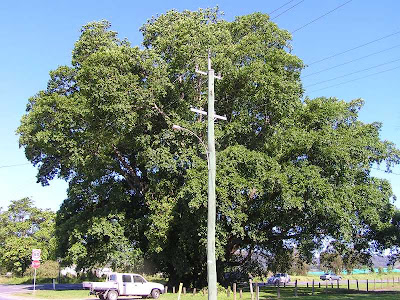 |
| The first (c1930) in a very long cycle of cutting to toparise the canopies of the figs (Picture curtesy of JCU Library collection) |
Queensland Rail have been historically a huge influence on the development of urban centres throughout regional Queensland, and the architectural form of the Townsville Station facade extended to the formal landscape in front of the building.
The choice of Ficus benjamina ~ weeping figs was not all that surprising except that the stock may have come from Brisbane, it is amusing to conjecture that they may have come from the plants collected by Walter Hill (perhaps one of the most influencial horticulturalists in Queensland through the 1880's).
We know from conversations with older railway employees that the trees were looked after by QR staff for many decades...in fact some pride is expressed about the cutting work carried out with cane knives from step ladders, and within the trees themselves.
Over time cvhanges in asset management has resulted in less regular maintenance for the trees and growth in the canopies has resulted in pronounced elongation of many limbs. This is not in itself a huge problem for such a robust species...except that some ill advised major flush cutting had left stem tissues exposed to expanding dysfunction and decay.
Where large columns of decay in the stem and very elongated limb growth come together this has proved to be a recipe for failure.
When determining what the best course for remediation, due consideration was given to the health and safety the general public together with the huge historical and cultural value that these tree represent for Townsville.
Given the observations of good health and vigour (other than the dysfunction and decay related to the past poor cutting practices) it was felt that if the movement of the failing section of the canopy could be arrested and the growing conditions improved, retention of the entire tree was practical and desirable.
In addition to the works relating to the recent failure these trees were to be hedged as part of the regular (now more regular than in the past) pruning program. Active planning to reduce asymmetry in other trees in the group is being incorporated into that program.
 |
| Legal requirement to provide clearance for road traffic will drive reduction on this side as much as any desire to reduce loading of the union with the scaffold limb |
Stephen Murphy and Tim Willey from Northern Tree Specialists carried out all the tree works on these trees, it is testiment to the ethos of their company and Queensland Rail that so much effort and resource is being provided to preserve these living reminders of the origins of the city of Townsville.
Following the installation fo the props (which were designed to specifications from a structrural engineer to be capable of supporting 8 tonnes each) the reduction pruning was carried out together with the hedging of the canopies.
There is no doubt I my opinion that this kind of pruing is amongst the most difficult to perform correctly. The pictures are not perhaps the best to illustrate the careful individual branch by branch selection of cutting points with the intention of locating nodes (growing points) within the branch outside of which the cut is made.
Often people lay claim to having carried out such pruning when really all they have done is 'lop' the tree paying no head to the structure of the branch and the presence of nodes. I think that Northern Tree Specialists have done a really good job in achieving the outcome visible in the canopy of the pruned tree.
It is hoped that future hedging cycles will encourage the growth and maintenance of foliage over the areas currently showing bare branches.
A video of the tree its problems and the installation of the props can be viewed on our video channel Preservation works on Veteran Fig Tree Townsville Railway Station




















